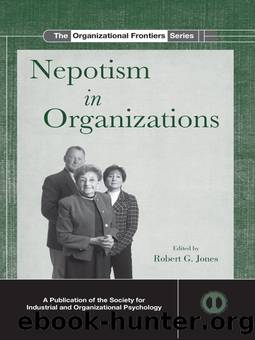Nepotism in Organizations by Jones Robert G

Author:Jones, Robert G.
Language: eng
Format: epub
Publisher: Taylor & Francis (CAM)
Published: 2012-09-14T16:00:00+00:00
GENERAL DISCUSSION
It seems that many people, including human resource managers, generally believe that nepotism is unethical and that it has negative effects on employees and business (Hayajenh et al., 1994; Prendergast & Taper, 1996). Nepotism can and perhaps often does have these characteristics, but I have argued that this need not always be the case. Rather, under some circumstances—as when the beneficiary relative is conscientious and agreeable, when important values are shared, and when commitments are compatible—conflict should not be an issue. Further, when dysfunctional conflict does occur, there are some situations—as when relevant parties have a high level of integrity, when the parties are highly committed to the enterprise, and the founder is a competent, trustworthy leader—where it may not severely damage the satisfaction of the parties or the success of the enterprise. Under these circumstances, the conflict may be functional, as in the case of an earnest debate about who should be the successor and why.
These notions are largely untested but deserve empirical investigation. To illustrate how the model in Figure 6.1 could be used to create concrete, testable hypotheses, I have offered several sample propositions throughout the chapter. With some effort, I suspect these could be developed into grounded, theoretically sound hypotheses worthy of research. Clever researchers could also build upon the model by identifying additional moderators, mediators, and dependent variables. For example, group cohesiveness could lead employees to respond more negatively or positively to nepotism depending on the group norm for commitment to the founder. That is, nepotism’s effect on conflict may be moderated by group dynamics such as cohesiveness and norms. As another example, the effect of conflict on the success of the enterprise is almost certainly moderated by organizational variables (e.g., strategy) and environmental factors (e.g., number and nature of competitors). In terms of mediation, the effects of conflict, leadership, and commitment to the enterprise are probably mediated by more proximal motivational variables (e.g., employees’ affect, cognitions, and goals). Finally, in addition to success of the enterprise and satisfaction of the parties, other potentially relevant outcomes include individual and unit-level performance (in-role and extra-role), withdrawal behaviors such as absenteeism and turnover and, perhaps most interesting, deviant behaviors (cf. Becker & Bennett, 2007).
One general implication of the model is that there are times when nepotism will lead to intractable, dysfunctional conflict. This could be because the personalities and values of relevant parties promote conflict, or differences in commitment profiles among the parties are antagonistic. In such cases, organizational change would be called for, as in replacing certain employees, attempting to alter people’s foci or bases of commitment, or dissolving nepotistic practices. In a presumably less plausible scenario, there could be companies moving toward nepotism, perhaps seeking the human capital rewards discussed by Jones et al. (2008). Whether approaching or retreating from nepotism, the usual change models may prove helpful.
Selecting people who accept change, promoting education and communication, allowing some level of participation, and executing change fairly may help to counter resistance (Fedor, Caldwell, & Herold, 2006; Fiss & Zajac, 2006; Kotter & Schlesinger, 1979).
Download
This site does not store any files on its server. We only index and link to content provided by other sites. Please contact the content providers to delete copyright contents if any and email us, we'll remove relevant links or contents immediately.
Time Management Made Easy: How to Cultivate New Habits, Improve Productivity and Get Things Done by Joshua Strachan(2367)
The 7 Habits of Highly Effective People by Stephen R. Covey & Sean Covey(2098)
The Concise Laws of Human Nature by Robert Greene(1718)
Doesn't Hurt to Ask by Trey Gowdy(1555)
Primal Leadership by Daniel Goleman(1129)
Hook Point: How to Stand Out in a 3-Second World by Brendan Kane(1098)
HBR's 10 Must Reads 2021 by unknow(1045)
Don't Sweat the Small Stuff...and It's All Small Stuff by Richard Carlson(1016)
Amazon Unbound by Brad Stone(980)
100 Things Successful People Do by Nigel Cumberland(964)
HBR's 10 Must Reads 2021 by Harvard Business Review(956)
The Job Closer by Steve Dalton(939)
Master of One by Jordan Raynor(934)
Lives of the Stoics by Ryan Holiday & Stephen Hanselman(900)
Declutter Your Mind: A step by step guide to learn to control your thoughts, stop worrying, relieve anxiety and eliminate panic attacks and negative thinking by Mia Chandler(875)
The Power of 100! by Shaun King(845)
Conflicted by Ian Leslie(798)
Coders at Work: Reflections on the craft of programming by Peter Seibel(789)
The Book of Hope by Jane Goodall(744)
